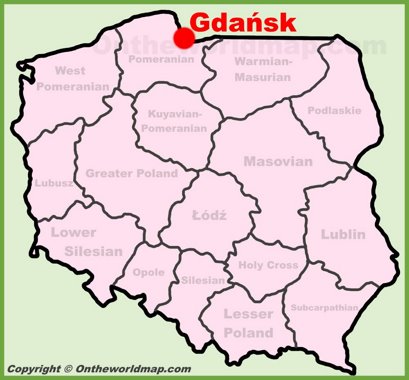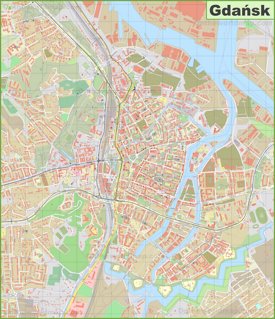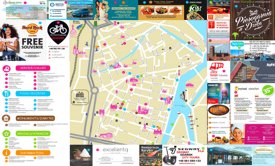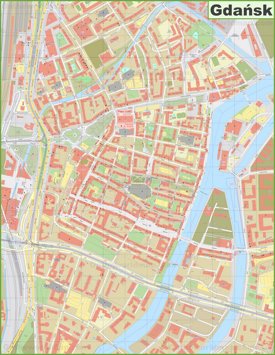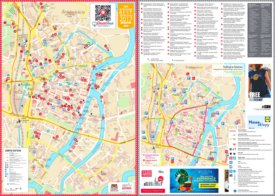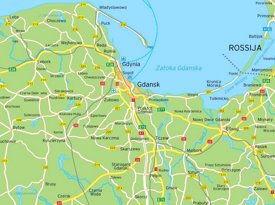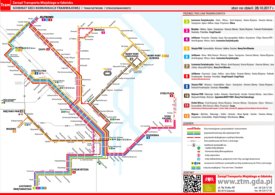Gdańsk Maps
Online Map of Gdańsk
About Gdańsk
Gdańsk is a major seaport and Poland's sixth-largest city, located on the Baltic coast. With a population of approximately 486,000 residents, it serves as the capital of the Pomeranian Voivodeship. The city's history spans over a thousand years, making it one of the oldest cities in Poland. Historically, Gdańsk was a prominent member of the Hanseatic League and has been a significant maritime trade center throughout its existence.
The city's strategic location at the mouth of the Vistula River has contributed to its economic importance. During the interwar period, Gdańsk held the status of a Free City under League of Nations protection. World War II began here on September 1, 1939, when German forces attacked the Polish military post at Westerplatte. The city suffered extensive damage during the war but was meticulously reconstructed in the post-war period.

The historic center of Gdańsk features remarkable architectural landmarks, including the Main Town Hall, St. Mary's Church (the largest brick church in the world), and the iconic Neptune's Fountain. The Royal Route, which runs through the heart of the Old Town, showcases the city's finest historical architecture, including the Green Gate, Golden Gate, and Long Market. The famous Long Lane (Długa Street) represents one of the most picturesque streets in Europe, lined with distinctive Dutch-influenced merchant houses.
Gdańsk holds significant importance in modern history as the birthplace of the Solidarity movement. The European Solidarity Centre and the Gdańsk Shipyard stand as testimonials to the workers' strikes of 1980, which ultimately contributed to the fall of communism in Eastern Europe. The city is also home to numerous museums, including the Museum of the Second World War, one of the largest historical museums in Poland.
Today, Gdańsk serves as a major economic hub, with shipbuilding, petrochemical industries, and tourism being key sectors. The city hosts Poland's largest seaport and is renowned for its amber trade, earning it the nickname "World Capital of Amber." The metropolitan area, known as the Tricity (along with neighboring Sopot and Gdynia), forms one of Poland's main cultural, commercial, and educational centers. The city's Lech Wałęsa International Airport connects it with major European destinations, handling over 5 million passengers annually.
The Facts:Voivodeship: Pomeranian.
Population: ~ 486,492 (30 June 2023).
Metropolitan population: 1,100,000.
Main sights in Gdańsk
- Highland Gate
- Golden Gate
- Ulica Długa
- Torture House (Katownia)
- Main Town Hall
- Długi Targ
- Neptune's Fountain
- Artus' Court
- Green Gate
- Abbot's Palace
- Olivia Business Centre
- Oliwa Cathedral
- Medieval city walls
- Brzeźno Pier
- Westerplatte
- National Museum
- Wisłoujście Fortress
- Historical Museum
- Museum of the Second World War
- National Maritime Museum
List of Districts of Gdańsk
- Aniołki
- Brętowo
- Brzeźno
- Chełm
- Jasień
- Kokoszki
- Krakowiec-Górki Zachodnie
- Letnica
- Matarnia
- Młyniska
- Nowy Port
- Oliwa
- Olszynka
- Orunia Górna-Gdańsk Południe
- Orunia-Św. Wojciech-Lipce
- Osowa
- Piecki-Migowo
- Przeróbka
- Przymorze Małe
- Przymorze Wielkie
- Rudniki
- Siedlce
- Śródmieście
- Stogi
- Strzyża
- Suchanino
- Ujeścisko-Łostowice
- VII Dwór
- Wrzeszcz Dolny
- Wrzeszcz Górny
- Wyspa Sobieszewska
- Wzgórze Mickiewicza
- Żabianka-Wejhera-Jelitkowo-Tysiąclecia
- Zaspa-Młyniec
- Zaspa-Rozstaje

